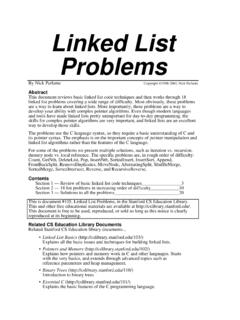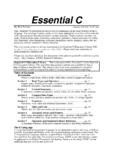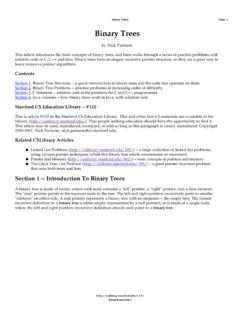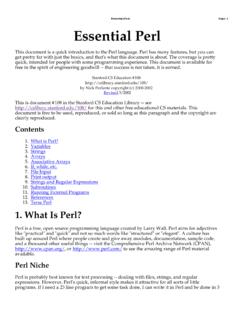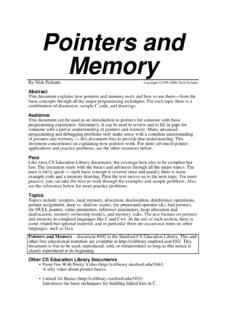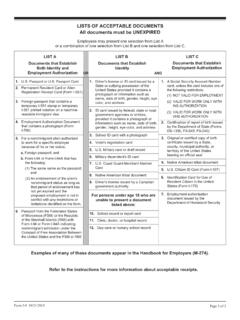Transcription of Linked List Basics - Stanford University
1 Linked ListBasicsBy Nick ParlanteCopyright 1998-2001, Nick ParlanteAbstractThis document introduces the basic structures and techniques for building Linked listswith a mixture of explanations, drawings, sample code, and exercises. The material isuseful if you want to understand Linked lists or if you want to see a realistic, appliedexample of pointer-intensive code. A separate document, Linked List Problems( ), presents 18 practice problems covering a wide rangeof lists are useful to study for two reasons. Most obviously, Linked lists are a datastructure which you may want to use in real programs. Seeing the strengths andweaknesses of Linked lists will give you an appreciation of the some of the time, space,and code issues which are useful to thinking about any data structures in less obviously, Linked lists are great way to learn about pointers.
2 In fact, youmay never use a Linked list in a real program, but you are certain to use lots of list problems are a nice combination of algorithms and pointer , Linked lists have been the domain where beginning programmers get thepractice to really understand article assumes a basic understanding of programming and pointers. The article usesC syntax for its examples where necessary, but the explanations avoid C specifics asmuch as possible really the discussion is oriented towards the important concepts ofpointer manipulation and Linked list Resources Link List Problems ( )Lots of linkedlist problems, with explanations, answers, and drawings. The "problems"article is a companion to this "explanation" article. Pointers and Memory ( )Explains allabout how pointers and memory work. You need some understanding ofpointers and memory before you can understand Linked lists .
3 Essential C ( )Explains all the basicfeatures of the C programming is document #103, Linked List Basics , in the Stanford CS Education Library. Thisand other free educational materials are available at Thisdocument is free to be used, reproduced, or sold so long as this notice is clearlyreproduced at its 1 Basic List Structures and Code2 Section 2 Basic List Building11 Section 3 Linked List Code Techniques17 Section 3 Code Examples22 EditionOriginally 1998 there was just one " Linked List" document that included a basicexplanation and practice problems. In 1999, it got split into two documents: #103 (thisdocument) focuses on the basic introduction, while #105 is mainly practice 4-12-2001 edition represents minor edits on the 1999 document is distributed for free for the benefit and education of all. That a personseeking knowledge should have the opportunity to find it.
4 Thanks to Stanford and myboss Eric Roberts for supporing me in this project. Best regards, Nick 1 Linked List BasicsWhy Linked lists ? Linked lists and arrays are similar since they both store collections of data. Theterminology is that arrays and Linked lists store "elements" on behalf of "client" code. Thespecific type of element is not important since essentially the same structure works tostore elements of any type. One way to think about Linked lists is to look at how arrayswork and think about alternate ReviewArrays are probably the most common data structure used to store collections ofelements. In most languages, arrays are convenient to declare and the provide the handy[ ] syntax to access any element by its index number. The following example shows sometypical array code and a drawing of how the array might look in memory. The codeallocates an array int scores[100], sets the first three elements set to contain thenumbers 1, 2, 3 and leaves the rest of the array ArrayTest() {int scores[100];// operate on the elements of the scores [0] = 1;scores[1] = 2;scores[2] = 3;}3 Here is a drawing of how the scores array might look like in memory.
5 The key point isthat the entire array is allocated as one block of memory. Each element in the array getsits own space in the array. Any element can be accessed directly using the [ ] index1299123231423-3451 Once the array is set up, access to any element is convenient and fast with the [ ]operator. (Extra for experts) Array access with expressions such as scores[i] isalmost always implemented using fast address arithmetic: the address of an element iscomputed as an offset from the start of the array which only requires one multiplicationand one disadvantages of arrays )The size of the array is fixed 100 elements in this case. Most often thissize is specified at compile time with a simple declaration such as in theexample above . With a little extra effort, the size of the array can bedeferred until the array is created at runtime, but after that it remains fixed.
6 (extra for experts) You can go to the trouble of dynamically allocating anarray in the heap and then dynamically resizing it with realloc(), but thatrequires some real programmer )Because of (1), the most convenient thing for programmers to do is toallocate arrays which seem "large enough" ( the 100 in the scoresexample). Although convenient, this strategy has two disadvantages: (a)most of the time there are just 20 or 30 elements in the array and 70% ofthe space in the array really is wasted. (b) If the program ever needs toprocess more than 100 scores, the code breaks. A surprising amount ofcommercial code has this sort of naive array allocation which wastes spacemost of the time and crashes for special occasions. (Extra for experts) Forrelatively large arrays (larger than 8k bytes), the virtual memory systemmay partially compensate for this problem, since the "wasted" elementsare never )(minor) Inserting new elements at the front is potentially expensivebecause existing elements need to be shifted over to make lists have their own strengths and weaknesses, but they happen to be strong wherearrays are weak.
7 The array's features all follow from its strategy of allocating the memoryfor all its elements in one block of memory. Linked lists use an entirely different we will see, Linked lists allocate memory for each element separately and only RefresherHere is a quick review of the terminology and rules for pointers. The Linked list code tofollow will depend on these rules. (For much more detailed coverage of pointers andmemory, see Pointers and Memory, ).4 Pointer/PointeeA "pointer" stores a reference to another variablesometimes known as its "pointee". Alternately, a pointer may be set to thevalue NULL which encodes that it does not currently refer to a pointee. (InC and C++ the value NULL can be used as a boolean false). DereferenceThe dereference operation on a pointer accesses its pointer may only be dereferenced after it has been set to refer to aspecific pointee.
8 A pointer which does not have a pointee is "bad" (below)and should not be dereferenced. Bad PointerA pointer which does not have an assigned a pointee is"bad" and should not be dereferenced. In C and C++, a dereference on abad sometimes crashes immediately at the dereference and sometimesrandomly corrupts the memory of the running program, causing a crash orincorrect computation later. That sort of random bug is difficult to trackdown. In C and C++, all pointers start out with bad values, so it is easyto use bad pointer accidentally. Correct code sets each pointer to have agood value before using it. Accidentally using a pointer when it is bad isthe most common bug in pointer code. In Java and other runtime orientedlanguages, pointers automatically start out with the NULL value, sodereferencing one is detected immediately. Java programs are much easierto debug for this reason.
9 Pointer assignmentAn assignment operation between two pointers likep=q; makes the two pointers point to the same pointee. It does not copythe pointee memory. After the assignment both pointers will point to thesame pointee memory which is known as a "sharing" situation. malloc()malloc() is a system function which allocates a block ofmemory in the "heap" and returns a pointer to the new block. Theprototype for malloc() and other heap functions are in Theargument to malloc() is the integer size of the block in bytes. Unlike local("stack") variables, heap memory is not automatically deallocated whenthe creating function exits. malloc() returns NULL if it cannot fulfill therequest. (extra for experts) You may check for the NULL case withassert() if you wish just to be safe. Most modern programming systemswill throw an exception or do some other automatic error handling in theirmemory allocator, so it is becoming less common that source code needsto explicitly check for allocation failures.
10 Free()free() is the opposite of malloc(). Call free() on a block of heapmemory to indicate to the system that you are done with it. The argumentto free() is a pointer to a block of memory in the heap a pointer whichsome time earlier was obtained via a call to malloc().What Linked lists Look LikeAn array allocates memory for all its elements lumped together as one block of contrast, a Linked list allocates space for each element separately in its own block ofmemory called a " Linked list element" or "node". The list gets is overall structure by usingpointers to connect all its nodes together like the links in a node contains two fields: a "data" field to store whatever element type the list holdsfor its client, and a "next" field which is a pointer used to link one node to the next node is allocated in the heap with a call to malloc(), so the node memory continuesto exist until it is explicitly deallocated with a call to free().
